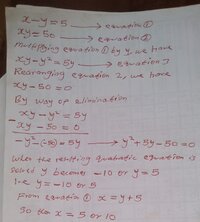x−y=5xy=50When solving
x−y=5 ....eq.(1)xy=50 ....eq.(2)from equation (1)
x=5+yx in equation (2), we have
(5+y)y=505y+y2=50y2+5y−50=0y=5, or y=-10
When y =5, x=5+5=10
Thus y=5, and x=10
When y=-10, x=5+(-10)=5-10=-5
Thus y=-10, x=-5
This has been solved simultaneously by method of substitution.
I know simultaneous linear equations can be solved by elimination method. If the above equation is simultaneous linear equations, can it be solved by elimination method? If yes. How can it be done?
x−y=5 ....eq.(1)xy=50 ....eq.(2)from equation (1)
x=5+yx in equation (2), we have
(5+y)y=505y+y2=50y2+5y−50=0y=5, or y=-10
When y =5, x=5+5=10
Thus y=5, and x=10
When y=-10, x=5+(-10)=5-10=-5
Thus y=-10, x=-5
This has been solved simultaneously by method of substitution.
I know simultaneous linear equations can be solved by elimination method. If the above equation is simultaneous linear equations, can it be solved by elimination method? If yes. How can it be done?

